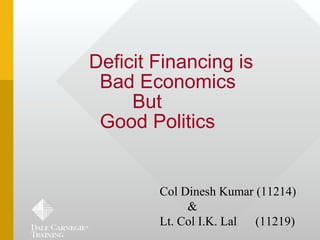
Deficit financing is bad economics but good politics
- 1. Deficit Financing is Bad Economics But Good Politics Col Dinesh Kumar (11214) & Lt. Col I.K. Lal (11219)
- 2. • Deficit financing is resorted to during three different situations :- • During War • During Depression • During Economic Development 2
- 3. Deficit Financing • Deficit financing occurs when there are budgetary deficits. • Budgetary Deficit is excess of total expenditure both revenue and capital over total receipts. 3
- 4. • Besides taxation, the government’s other major revenue source is borrowing. • Deficit Financing refers to financing the difference of expenditure over revenue through borrowings. • Higher deficit implies higher borrowings and thus higher interest payments. 4
- 5. 05/07/12
- 6. • Deficits have generally been the rule (although there was a surplus from 1999 to 2000). • Deficit (as fraction of GDP) was highest in mid-1980s. 6
- 7. Deficit Financing And Inflation • Deficit financing creates monetary incomes and demand for goods and services increases. • Though there is increased demand, availability of consumer goods takes time & prices rise. • Also increase in money supply lead to credit creation which aggravates inflationary conditions. 7
- 8. Price Rise • There is a close relationship between rate of increase in prices & growth in money supply. • Prices have tendency to rise at every successive increase in money supply. 8
- 9. Limitation of Deficit Financing • Deficit financing is inevitable under planned economic development to activate unutilized resources or step up tempo of economic process. • It is necessary to the extent it can promote capital formation and economic development. 9
- 10. PATTERN OF DEFICIT FINANCING • Gross Fiscal Deficit comprises of revenue & capital deficit. • Revenue deficit has shown continuous increasing trend. • Almost 60% of deficit is due to non plan expenditure. (i) Interest payment (ii) Defence (iii)Subsidies & inefficient PSUs 05/07/12
- 11. HEAVY INTREST BURDEN • Continuous increase in revenue deficit depicts continuous deterioration in the fiscal situation. • Considerable part of net borrowings is utilized simply for payment of interest. • Public borrowings not being used for productive investment but only for consumption expenditure. • It further widens the gap between net revenue & net expenditure. 05/07/12
- 12. WAY OUT OF FINANCIAL CRISIS • Prudent fiscal management is need of the hour. • Reduce growth of revenue expenditure by cutting down subsidies, introducing agriculture income tax, etc. 05/07/12
- 13. GOOD POLITICS MEANS BAD ECONOMICS Hence, we have • Fiscal profligacy in place of prudence. • Policy paralyses • Food security act instead of subsidies • Concern of political India – maintain fuel subsidy, announce populist schemes • Concern of productive India – steep decline of rupee, fiscal deficit BoP crunch, retrospective tax steady decline in GDP growth.
- 14. Thank you
